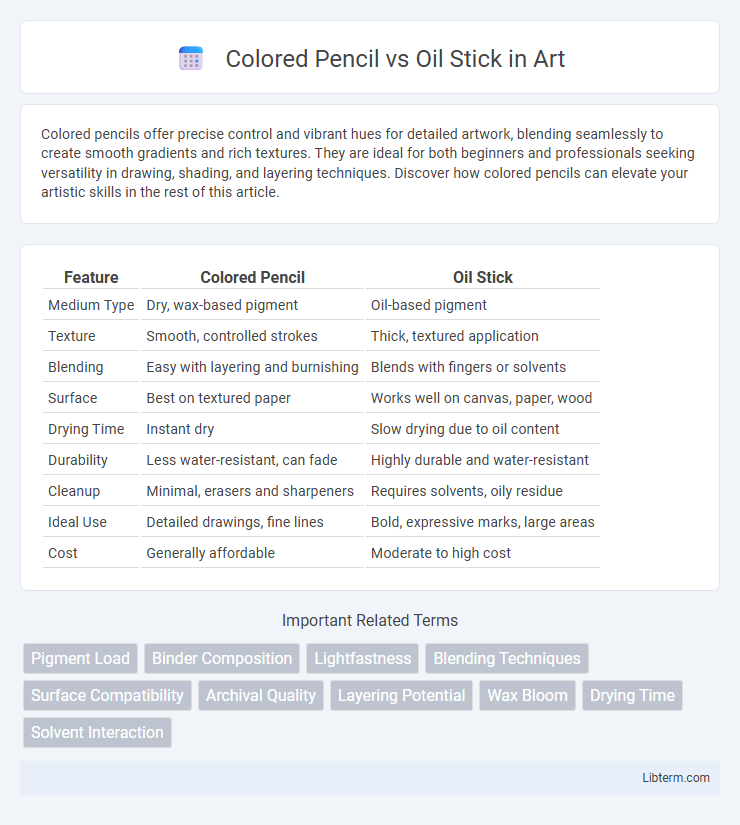Colored pencils offer precise control and vibrant hues for detailed artwork, blending seamlessly to create smooth gradients and rich textures. They are ideal for both beginners and professionals seeking versatility in drawing, shading, and layering techniques. Discover how colored pencils can elevate your artistic skills in the rest of this article.
Table of Comparison
| Feature | Colored Pencil | Oil Stick |
|---|---|---|
| Medium Type | Dry, wax-based pigment | Oil-based pigment |
| Texture | Smooth, controlled strokes | Thick, textured application |
| Blending | Easy with layering and burnishing | Blends with fingers or solvents |
| Surface | Best on textured paper | Works well on canvas, paper, wood |
| Drying Time | Instant dry | Slow drying due to oil content |
| Durability | Less water-resistant, can fade | Highly durable and water-resistant |
| Cleanup | Minimal, erasers and sharpeners | Requires solvents, oily residue |
| Ideal Use | Detailed drawings, fine lines | Bold, expressive marks, large areas |
| Cost | Generally affordable | Moderate to high cost |
Introduction: Colored Pencil vs Oil Stick
Colored pencils provide precise control and vibrant detailing with a dry, wax-based pigment, ideal for fine lines and subtle shading. Oil sticks, composed of oil paint in stick form, offer rich, bold textures and effortless blending with a creamy consistency suited for expressive, painterly effects. Choosing between colored pencil and oil stick depends on the desired finish, technique, and the artist's preference for either detailed line work or dynamic, textured coverage.
Overview of Colored Pencils
Colored pencils offer precise control and vibrant hues, ideal for detailed artwork and smooth blending. Composed of pigments mixed with a binder, these tools enable layering and shading with ease on various paper textures. Their versatility and portability make colored pencils a favorite medium for both beginners and professional artists seeking fine lines and subtle tonal variations.
Overview of Oil Sticks
Oil sticks are a versatile medium combining the buttery texture of oil paint with the convenience of a drawing tool, allowing artists to apply rich, opaque colors directly onto various surfaces. Unlike colored pencils, oil sticks provide vibrant pigmentation and a blendable, textured finish that can be manipulated with brushes or palette knives. Their compatibility with traditional oil paints makes oil sticks ideal for expressive, layered artworks requiring dynamic color and tactile depth.
Core Material Differences
Colored pencils use pigment cores bound with wax or oil-based binders, offering precise control and fine detail work. Oil sticks contain thick, oil-based cores similar to oil paints, allowing for rich texture and blending on canvas or textured surfaces. The core density and binder types in oil sticks create a more painterly effect, while colored pencils provide sharper lines and layered color application.
Color Vibrancy and Pigmentation
Colored pencils offer precise control with vibrant hues due to finely ground pigments suspended in wax or oil-based cores, resulting in smooth layering and subtle color gradients. Oil sticks deliver intense pigmentation and richer color vibrancy because of their thick, buttery consistency and higher concentration of oil-bound pigments, ideal for bold, textured applications. Both mediums excel in color expression, but oil sticks provide more saturation and dynamic depth, while colored pencils allow for detailed and controlled color blending.
Blending and Layering Techniques
Colored pencils offer precise control for detailed layering, allowing artists to build rich textures through multiple translucent layers, enhancing color depth incrementally. Oil sticks provide a creamy consistency that facilitates smooth blending directly on the surface, enabling seamless transitions and bold, painterly effects with rapid coverage. Combining these mediums allows artists to exploit the vibrant layering of colored pencils and the dynamic blending capabilities of oil sticks for diverse textural outcomes.
Surface Compatibility
Colored pencils are highly compatible with smooth, textured paper surfaces, allowing precise layering and blending, while oil sticks perform best on primed canvases, wood panels, and textured paper that can hold the oil medium without smudging. The waxy, oily nature of oil sticks requires surfaces with some absorbency or tooth to prevent slipping and enable richer, vibrant strokes. Colored pencils demand a firm, even surface for detail work, whereas oil sticks thrive on rougher, sturdier surfaces for better pigment adhesion and dynamic texture effects.
Drying Time and Longevity
Colored pencils require no drying time as their pigments are bound in wax or oil-based cores, allowing immediate handling and layering. Oil sticks, composed of oil-infused pigments, need extended drying periods that can span days or weeks depending on thickness and environmental conditions to fully cure. In terms of longevity, oil sticks generally offer superior durability and resistance to fading over time compared to colored pencils, which are more prone to smudging and color degradation without proper sealing.
Artistic Uses and Styles
Colored pencils offer precision and control ideal for detailed and layered artwork, allowing artists to create fine lines and subtle gradients in realistic or illustrative styles. Oil sticks provide rich, vibrant pigmentation and a buttery texture best suited for expressive, bold strokes and impasto techniques in abstract or impressionistic paintings. Both mediums enable diverse artistic expression, with colored pencils favored for intricate work and oil sticks preferred for dynamic, textured applications.
Choosing the Right Medium for Your Art
Choosing between colored pencils and oil sticks depends on your desired texture and blending capabilities; colored pencils offer precision and fine detail with easy layering, while oil sticks provide rich, vibrant colors and a painterly effect with smooth blending. Consider the surface you plan to work on, as colored pencils are best for paper and detailed work, whereas oil sticks are suited for canvas and heavier textures. Your artistic style and workflow will guide the best medium choice, balancing control and expressiveness for optimal results.
Colored Pencil Infographic

 libterm.com
libterm.com